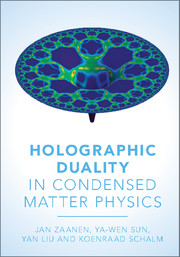Book contents
- Frontmatter
- Contents
- Preface
- 1 Introduction
- 2 Condensed matter: the charted territory
- 3 Condensed matter: the challenges
- 4 Large-N field theories for holography and condensed matter
- 5 The AdS/CFT correspondence as computational device: the dictionary
- 6 Finite-temperature magic: black holes and holographic thermodynamics
- 7 Holographic hydrodynamics
- 8 Finite density: the Reissner–Nordström black hole and strange metals
- 9 Holographic photoemission and the RN metal: the fermions as probes
- 10 Holographic superconductivity
- 11 Holographic Fermi liquids: the stable Fermi liquid and the electron star as holographic dual
- 12 Breaking translational invariance
- 13 AdS/CMT from the top down
- 14 Outlook: holography and quantum matter
- References
- Index
9 - Holographic photoemission and the RN metal: the fermions as probes
Published online by Cambridge University Press: 05 November 2015
- Frontmatter
- Contents
- Preface
- 1 Introduction
- 2 Condensed matter: the charted territory
- 3 Condensed matter: the challenges
- 4 Large-N field theories for holography and condensed matter
- 5 The AdS/CFT correspondence as computational device: the dictionary
- 6 Finite-temperature magic: black holes and holographic thermodynamics
- 7 Holographic hydrodynamics
- 8 Finite density: the Reissner–Nordström black hole and strange metals
- 9 Holographic photoemission and the RN metal: the fermions as probes
- 10 Holographic superconductivity
- 11 Holographic Fermi liquids: the stable Fermi liquid and the electron star as holographic dual
- 12 Breaking translational invariance
- 13 AdS/CMT from the top down
- 14 Outlook: holography and quantum matter
- References
- Index
Summary
The general nature of the holographic strange metals as discussed in the previous chapter took some time to be appreciated. Triggered by the studies dating from 2007 by Herzog, Kovtun, Sachdev and Son of quantum critical transport which we described in chapter 7, the AdS/CMT development as focussed on quantum matter started in 2008 with the discovery that the RN metal is quite susceptible to spontaneous symmetry breaking: this is the holographic superconductor [347, 348]. What thoroughly accelerated the interest in the condensed matter applications of AdS/CFT was the discovery in 2009 of the “MIT–Leiden fermions” [349, 350]. This will be the topic of this chapter. In hindsight, this was a highlight of the crossdisciplinary exchange between condensed matter physics and string theory. Driven by experimental progress during the last twenty years or so, angular-resolved photoemission (ARPES) (and in principle also its “unoccupied-states sibling” inverse photoemission) has acquired a very prominent status as a means to “observe” strongly interacting systems in solids. It has been further fortified by the quite recent development of scanning tunnelling spectroscopy (STS), which can be seen as the real-space partner of ARPES. Together these spectroscopies have produced a barrage of serendipitous surprises during the last 15 years, and now play a prominent role in the flourishing of the experimental study of the strongly correlated electron systems.
Both methods probe the single-fermion two-point function. For string theorists with their traditional focus on high-energy experimentation and cosmology, the importance of the single-fermion propagator as an observational tool is less obvious. Its unique powers come into play in finite-density systems. Compared with the collective “bosonic” current responses which were in the foreground in the previous two chapters, it yields complementary but yet quite different information regarding the vacuum structure of the interacting system. One advantage is of a rather pragmatic nature. In practice one can measure the bosonic responses often only at small momenta, where general “hydrodynamics” principles tend to equalise the outcomes – see the discussion of zero sound and optical conductivity of the RN metal in section 8.3. On the other hand, photoemission (and its siblings) accesses the full kinematical range associated with the electrons in solids: state-ofthe- art spectrometers probe length scales ranging from multiple nanometres to the sub-Ångström scale and energies ranging from sub-kelvin to electron volts.
- Type
- Chapter
- Information
- Holographic Duality in Condensed Matter Physics , pp. 291 - 327Publisher: Cambridge University PressPrint publication year: 2015



